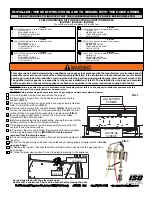
(C) INSTALLATION INTO MASONRY FLUE
1. Masonry flues for use with solid fuel appliances
must meet the NATIONAL FIRE PROTECTION
ASSOCIATIONS CODE 211 specifications.
2. Connection to the masonry flue is made with a
masonry or terra-cotta type thimble cemented firmly
in place.
3. Material around the thimble connection must
provide adequate protection from fire. Use either 24”
or solid masonry, or an approved insulated connector.
4. Stove pipe should be inserted far enough into the
thimble to assure a good connection, but must not
extend past the flue lining.
5. Do not use more than one elbow in the stove pipe.
6. Re-check all clearances.
(D) INSTALLATION INTO FACTORY-BUILT
CHIMNEY
1. After the stove is positioned, suspend a plumb bob
over the center of the damper to determine the
chimney penetration point.
2. The Appalachian Stove must be connected ONLY
to UL listed class “HT” all-fuel burning heating
appliance chimneys. CAUTION: SOME CHIMNEYS
ARE AVAILABLE WITH UL LISTING THAT ARE
NOT CLASS “HT,” AND ARE NOT SAFE FOR USE
WITH A SOLID FUEL APPLIANCE.
3. Install the chimney following the manufacturer’s
instructions. DO NOT DEVIATE FROM THESE
INSTRUCTIONS!
4. The chimney should extend a minimum of 3 feet
from the roof structure, or 2 feet higher that the
highest point within 10 feet, whichever is greater.
This assures proper chimney function and reduces the
possibility of backdrafts.
NOTE: All installations must meet local building and
fire codes. Check with your local building officials
for assistance in getting permits, inspections and
advice.
NOTE: Use of aluminum type B gas vent for solid
fuels is unsafe and prohibited by the National Fire
Protection Association Code.
FIGURE 9
INSTALLATION INTO MASONRY FLUE
FIGURE 10
INSTALLATION INTO
FACTORY-BUILT CHIMNEY
10
Summary of Contents for 30 CD
Page 20: ......





































